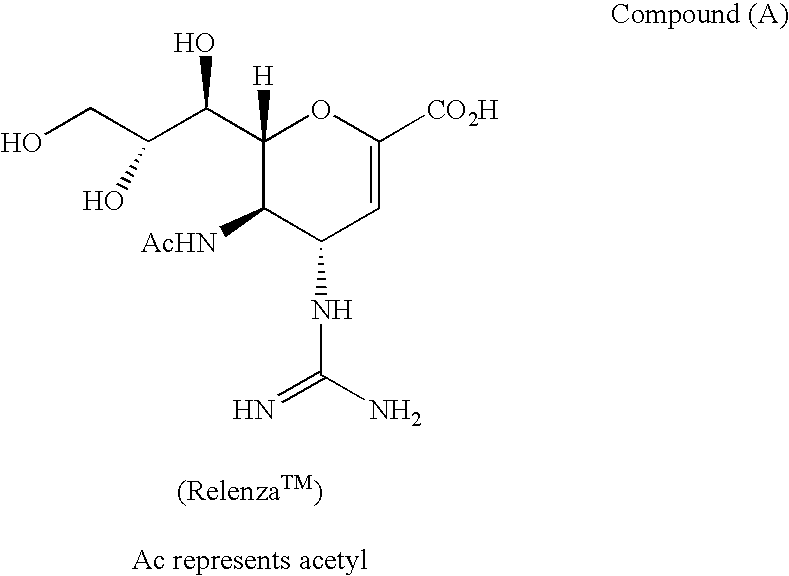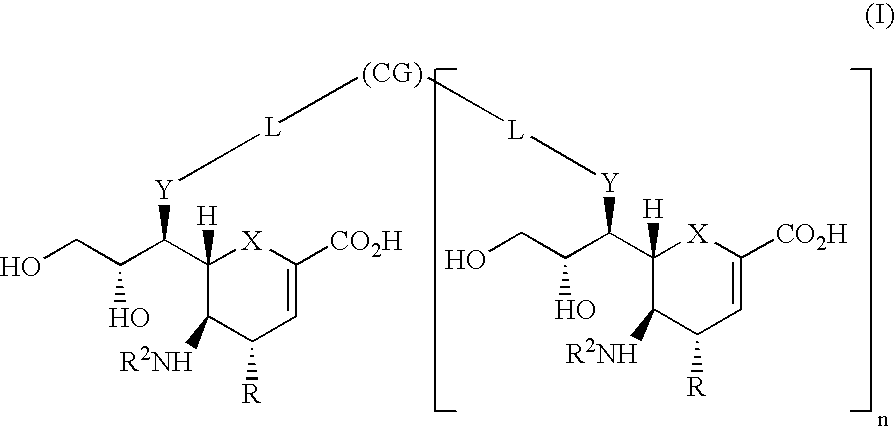Multivalent neuraminidase inhibitor conjugates
a neuraminidase inhibitor and conjugate technology, applied in the direction of biocide, biochemical equipment and processes, plant growth regulators, etc., can solve the problems of significant morbidity, only about 70% effective immunization in preventing infection, and known serious side effects
- Summary
- Abstract
- Description
- Claims
- Application Information
AI Technical Summary
Benefits of technology
Problems solved by technology
Method used
Image
Examples
example 1
Preparation of an ethylenediaminetetraacetamido derivative (3) of 5-acetamido-7-(6-aminohexylcarbamoyloxy)-4-guanidino-2,3,4,5-tetradeoxy-D-glycero-D-galacto-non-2-enopyranosonic acid [Tetramer of Compound (2)]
[0178]
[0179]The 7-carbamate derivative (2a) was prepared following a similar procedure to that described in our earlier patent application PCT / AU97 / 00109.
[0180]Compound (2a) (40 mg, 5.39×10−5 mole), ethylenediaminetetraacetic acid dianhydride (7 mg, 2.69×10−5 mole) and pyridine (6.8 μl, 8.07×10−5 mole) were stirred in dimethylformamide (200 μl) at 50° C. for 3 h. The reaction mixture was co-evaporated with toluene to afford compound (5) as a white foam (44 mg).
[0181]LC Rt2.1 min, MS 643 [M+2H]2+, (method A);
[0182]TOF 643.3 [M+2H]2+, 1285.5 [M+H]+, (method B),
[0183]To a solution of dimer (5) (200 mg, 1.557×10−4 mole) in dimethylformamide (3 ml) was added benzotriazol-1-yloxy tris(pyrrolidino)phosphonium hexafluorophosphate (162 mg, 3.12×10−4 mole), compound (2) (231 mg, 3.12×1...
example 2
Preparation of the Trimer (4) from 1,3,5-Benzenetricarboxylic (Trimesic) Acid and Compound (2a)
[0212]Mass spectrometry was performed on a Micromass Platform II mass spectrometer with electrospray ionisation and positive ion detection. RP-HPLC purification was performed with a Gilson HPLC system comprising of a Gilson 322 pumping system, a Gilson 215 Fraction Collector and a Hewlett Packard 1100 Photodiode Array Detector. The purified yields for compounds 4a and 4 have been calculated based on the molecular weight of a tris-trifluoroacetic acid complex.
Synthesis
Reaction A
[0213]
[0214]Compound 2a (62.0 mg, 8.33×10−5 mol), trimesic acid (I) (5.0 mg, 2.38×10−5 mol) and benzotriazol-1-yloxy-tris(dimethylamino)phosphonium hexafluorophosphate (BOP) (37.0 mg, 8.33×10−5 mol) were dissolved in DMF (2 mL) and stirred at room temperature. Diisopropylethyl amine (90 ul, 5.16×10−5 mol) was then added to the above solution and the solution was allowed to stir at room temperature for 5 hours. The c...
example 3
Alternative Synthesis of Tetramer (Compound (3))
[0223]
[0224]Ethylenediaminetetraacetic dianhydride (2.36 g), N-(6-aminohexyl)carbamic acid t-butyl ester (4.00 g), pyridine (1.9 mL) and dimethylformamide (10 mL) were stirred at room temperature overnight followed by warming to 55° C. for 3 h. The solvent was then removed in vacuo and azeotroped with toluene (3×25 mL) to afford Compound (6) (6.3 g).
[0225]Mass spec. MH+ 689
[0226]
[0227]Compound (6) (500 mg, 0.73 mmol) was dissolved in anhydrous dimethylformamide (2.0 mL). Diisopropylethylamine (1.0 mL), Hydroxybenzotriazole (194 mg) and benzotriazol-1-yloxytris(pyrrolidino)phosphonium hexafluorophosphate (760 mg) were added consecutively. The reaction was stirred under a nitrogen atmosphere at room temperature for 15 minutes. N-(6-aminohexyl)carbamic acid t-butyl ester hydrochloride (405 mg) was added and the reaction stirred at room temperature overnight. Solvent was removed in vacuo, and the residue redissolved in 1:1 v / v diethyl ethe...
PUM
| Property | Measurement | Unit |
|---|---|---|
| mass median aerodynamic diameter | aaaaa | aaaaa |
| temperature | aaaaa | aaaaa |
| pH | aaaaa | aaaaa |
Abstract
Description
Claims
Application Information
 Login to View More
Login to View More - R&D
- Intellectual Property
- Life Sciences
- Materials
- Tech Scout
- Unparalleled Data Quality
- Higher Quality Content
- 60% Fewer Hallucinations
Browse by: Latest US Patents, China's latest patents, Technical Efficacy Thesaurus, Application Domain, Technology Topic, Popular Technical Reports.
© 2025 PatSnap. All rights reserved.Legal|Privacy policy|Modern Slavery Act Transparency Statement|Sitemap|About US| Contact US: help@patsnap.com



